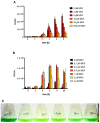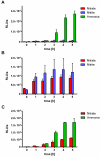Nitrogen Starvation Acclimation in Synechococcus elongatus: Redox-Control and the Role of Nitrate Reduction as an Electron Sink
- PMID: 25780959
- PMCID: PMC4390884
- DOI: 10.3390/life5010888
Nitrogen Starvation Acclimation in Synechococcus elongatus: Redox-Control and the Role of Nitrate Reduction as an Electron Sink
Abstract
Nitrogen starvation acclimation in non-diazotrophic cyanobacteria is characterized by a process termed chlorosis, where the light harvesting pigments are degraded and the cells gradually tune down photosynthetic and metabolic activities. The chlorosis response is governed by a complex and poorly understood regulatory network, which converges at the expression of the nblA gene, the triggering factor for phycobiliprotein degradation. This study established a method that allows uncoupling metabolic and redox-signals involved in nitrogen-starvation acclimation. Inhibition of glutamine synthetase (GS) by a precise dosage of l-methionine-sulfoximine (MSX) mimics the metabolic situation of nitrogen starvation. Addition of nitrate to such MSX-inhibited cells eliminates the associated redox-stress by enabling electron flow towards nitrate/nitrite reduction and thereby, prevents the induction of nblA expression and the associated chlorosis response. This study demonstrates that nitrogen starvation is perceived not only through metabolic signals, but requires a redox signal indicating over-reduction of PSI-reduced electron acceptors. It further establishes a cryptic role of nitrate/nitrite reductases as electron sinks to balance conditions of over-reduction.
Figures










Similar articles
-
Nitrogen starvation in synechococcus PCC 7942: involvement of glutamine synthetase and NtcA in phycobiliprotein degradation and survival.Arch Microbiol. 1999 Oct;172(4):247-55. doi: 10.1007/s002030050767. Arch Microbiol. 1999. PMID: 10525742
-
Role of calcium in acclimation of the cyanobacterium Synechococcus elongatus PCC 7942 to nitrogen starvation.Microbiology (Reading). 2009 Jan;155(Pt 1):25-34. doi: 10.1099/mic.0.022251-0. Microbiology (Reading). 2009. PMID: 19118343
-
Nitrogen-starvation-induced chlorosis in Synechococcus PCC 7942: adaptation to long-term survival.Microbiology (Reading). 1998 Sep;144 ( Pt 9):2449-2458. doi: 10.1099/00221287-144-9-2449. Microbiology (Reading). 1998. PMID: 9782492
-
Recovery of Unicellular Cyanobacteria from Nitrogen Chlorosis: A Model for Resuscitation of Dormant Bacteria.Microb Physiol. 2021;31(2):78-87. doi: 10.1159/000515742. Epub 2021 Apr 20. Microb Physiol. 2021. PMID: 33878759 Review.
-
Nitrogen chlorosis in unicellular cyanobacteria - a developmental program for surviving nitrogen deprivation.Environ Microbiol. 2019 Apr;21(4):1173-1184. doi: 10.1111/1462-2920.14447. Epub 2018 Nov 21. Environ Microbiol. 2019. PMID: 30318768 Review.
Cited by
-
Differential Effects of Varying Concentrations of Phosphorus, Iron, and Nitrogen in N2-Fixing Cyanobacteria.Front Microbiol. 2020 Sep 25;11:541558. doi: 10.3389/fmicb.2020.541558. eCollection 2020. Front Microbiol. 2020. PMID: 33101223 Free PMC article.
-
Reannotation of the Ribonucleotide Reductase in a Cyanophage Reveals Life History Strategies Within the Virioplankton.Front Microbiol. 2019 Feb 5;10:134. doi: 10.3389/fmicb.2019.00134. eCollection 2019. Front Microbiol. 2019. PMID: 30804913 Free PMC article.
-
Physiological and molecular evidence for phycobilisome degradation in maintaining carbon and nitrogen balance of cyanobacteria.Mar Life Sci Technol. 2025 Apr 25;7(2):218-230. doi: 10.1007/s42995-025-00290-0. eCollection 2025 May. Mar Life Sci Technol. 2025. PMID: 40417252 Free PMC article.
-
Redox crisis underlies conditional light-dark lethality in cyanobacterial mutants that lack the circadian regulator, RpaA.Proc Natl Acad Sci U S A. 2017 Jan 24;114(4):E580-E589. doi: 10.1073/pnas.1613078114. Epub 2017 Jan 10. Proc Natl Acad Sci U S A. 2017. PMID: 28074036 Free PMC article.
-
A Hard Day's Night: Cyanobacteria in Diel Cycles.Trends Microbiol. 2019 Mar;27(3):231-242. doi: 10.1016/j.tim.2018.11.002. Epub 2018 Dec 5. Trends Microbiol. 2019. PMID: 30527541 Free PMC article. Review.
References
-
- Vitousek P.M., Howarth R.W. Nitrogen limitation on land and in the sea: How can it occur? Biogeochemistry. 1991;13:87–115.
-
- Schwarz R., Forchhammer K. Acclimation of unicellular cyanobacteria to macronutrient deficiency: Emergence of a complex network of cellular responses. Microbiology. 2005;151:2503–2514. - PubMed
-
- Allen M.M., Smith A.J. Nitrogen chlorosis in blue-green algae. Archiv fur Mikrobiologie. 1969;69:114–120. - PubMed
LinkOut - more resources
Full Text Sources
Other Literature Sources

